Mintaka is a multiple star system located in the constellation of Orion. It is also one of the three main stars that form Orion’s Belt. It is the seventh brightest star in Orion and the 73rd brightest star in the night sky.
Key Facts & Summary
- Mintaka, also known as Delta Orionis and 34 Orionis, is around 1.200 light-years / 380 parsecs away from the sun.
- The star system’s combined visual magnitude is 2.23. It is the faintest object that forms Orion’s familiar hourglass shape. Its absolute magnitude is at around -5.8.
- Mintaka is the westernmost star of Orion’s Belt.
- The primary component is a triple star system consisting of a class 09.5 bright giant and a class B main-sequence star. They orbit around each other once every 5.73 days.
- The star is around 190.000 times more luminous than the Sun. The primary star, Mintaka Aa1, is 24 times more massive than our sun. It has surface average temperatures of around 29.000 K. Its radius is around 16.5 times that of the sun.
- The ages of all the stars of the Mintaka system are currently unknown but they are part of the Orion OB1 Association, which is part of the Orion Molecular Cloud Complex – a star-forming region with stellar ages ranging up to 12 million years old.
- Mintaka Aa2 is 8.4 times as massive as the sun and has around 6.5 solar radii. It is 16.000 times brighter than our sun and its average surface temperatures are around 25.600 K.
- The third star, Mintaka Ab is 22.5 times more massive than our sun. It has around 10.4 solar radii and it is 63.000 times brighter. The average surface temperatures are estimated to be around 28.400 K
- The fourth, Mintaka B, has only 0.77 solar radii, 0.4 the sun’s luminosity and its surface temperatures are around 5.324 K, similar to the sun’s.
- The fifth component, HD 36485, is around 9 times more massive than the sun with around 5.7 solar radii. It is 3.300 times brighter, and its average surface temperature is around 18.400 K.
Mintaka is the westernmost star of the famous Orion’s Belt asterism. This asterism has been known for thousands of years and was associated with many myths and religious beliefs.
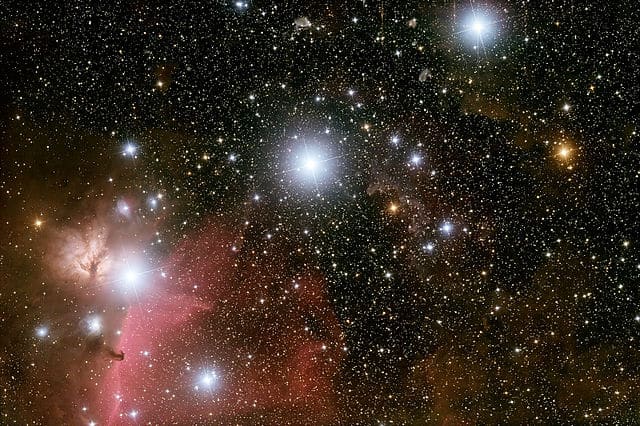
Mintaka is a word of Arabic origin and roughly translates to “belt.” Orion’s Belt itself was collectively known by many names in many cultures throughout the ages. The other two stars forming Orion’s Belt are Alnilam and Alnitak.
Formation
The constellation of Orion is home to many blue stars, clusters, nebulae, and clouds of dust and gas. Star formation is pretty active in this region. All the three stars in Orion’s Belt, for example, have many other companion stars around them, thus they form multiple star systems (with the exception of Alnilam).
Mintaka is the most complex stellar system out of the stars forming Orion’s Belt. Its age is also elusive but it is clearly much younger than our sun, in fact, all the stars in Orion’s Belt are.

Mintaka – Delta Orionis –belongs to the Orion OB1 association in the subgroup OB1b which is part of the Orion Molecular Cloud Complex – a star-forming region with stellar ages ranging up to 12 million years old. As such, the star's age cannot exceed 12 million years. At a certain point in time, gas and dust from Orion’s molecular cloud, were pulled together by gravity and resulted in the many stars we now see in Orion, and thus Orion’s Belt. Since Mintaka’s age is unknown, it is uncertain whether all of its companion stars formed at the same time or at different intervals.
Distance, Size, and Mass
Mintaka is located at around 1.200 light-years / 380 parsecs away from the Sun. Some estimates put it even farther or closer. The primary star, Mintaka Aa1 is the biggest of the star system, more than 20 times bigger than our sun. It is, however, the smallest and least massive star in Orion’s Belt.
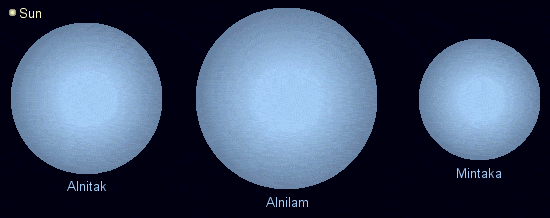
Mintaka Aa1 has a mass of around 24 solar masses and a radius of about 16.5 times that of the sun. The second biggest star in the system is Mintaka Ab, which has around 22.5 solar masses and a radius of around 10.4 solar radii.
The third star is Mintaka Aa2, at around 8.4 solar masses and a radius of 6.5 solar radii. The fourth star is HD 36485, with an estimated 5.7 solar radii, and a mass speculated to be around 9 times that of the sun. The fifth star is even smaller than our sun, Mintaka B has only 77% of our sun’s radius while its mass remains unknown.
Other Characteristics
The primary star, Mintaka Aa1 is the brightest – around 190.000 times brighter than our sun, and the hottest star of the system, at around 5.1 times hotter than our sun. It has surface temperatures of around 29.500 K. It is a blue giant star of spectral class O9.5II. It has an absolute magnitude of -5.4 and a rotational velocity of around 130 km / 80.7 mi per second.
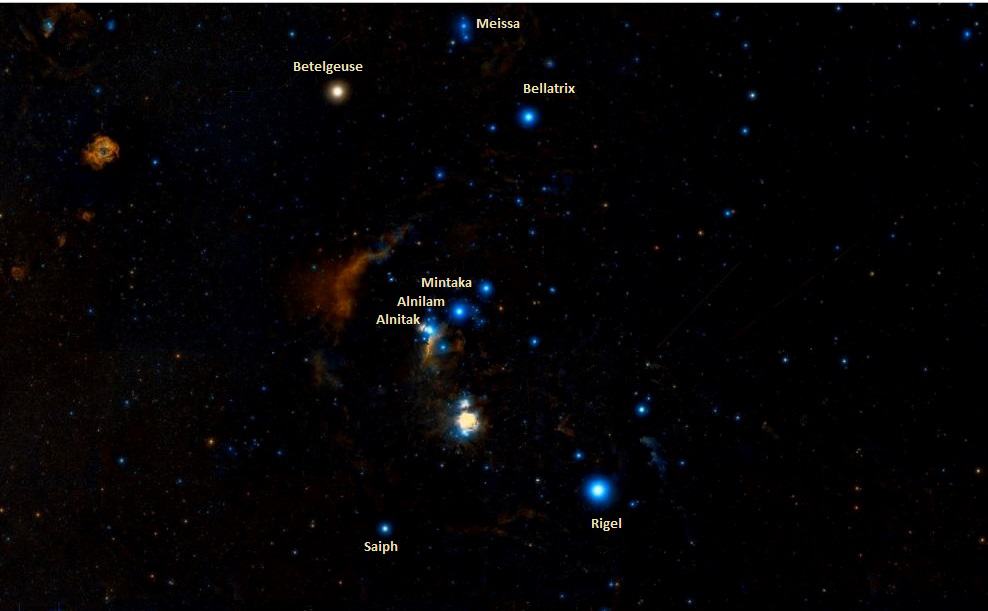
Mintaka Ab is the second brightest of the system, at around 63.000 times brighter than our sun. It is also the second hottest, with surface temperatures at around 28.400 K. It is 4.9 times hotter than our sun. Mintaka Ab is a subgiant star of spectral class B0IV. It has an absolute magnitude of -4.2 and a rotational velocity of around 220 km / 136.7 mi per second.
Mintaka Aa2 is the third brightest of the system, being 16.000 times brighter than our sun. It is also the third hottest, with surface temperatures at around 25.600 K. It is 4.4 times hotter than our sun. It is a giant star of spectral type B1V. It has an absolute magnitude of -2.9, and a rotational velocity of around 150 km / 93 mi per second.

HD 36485 is the fourth brightest of the system, being 3.300 times brighter than our sun. It is also the fourth hottest, with surface temperatures of around 18.400 K. It is 3.1 times hotter than our sun. It is a main-sequence star with a spectral classification of class B.
Mintaka B is the faintest of the system. Having 0.431 solar luminosities. Its surface temperatures are almost similar to the sun’s, at around 5.34 K. It is a 14th magnitude star.
Stellar System
Mintaka Aa1 and Aa2 orbit each other with a period of 5.73 days. This causes slight variations in brightness since they are an eclipsing binary system – the closest such system to Earth. Mintaka Ab is separated by 0.26” from the main pair and orbits the primary star with a period of more than 400 years.
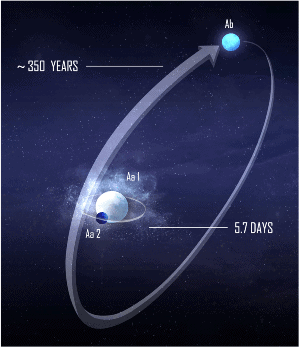
The first eclipse causes the magnitudes to drop from 2.23 to 2.35, while the second eclipse makes it drop to 2.29. HD 36485 is a spectroscopic binary system with a dim class A companion. The stars orbit each other every 30 days. It is unknown if Mintaka B is truly related to the Mintaka star system.
Location
Mintaka is located in the constellation of Orion, the celestial hunter. It is part of the three stars forming the hunter’s belt, being the westernmost star. Orion’s Belt is often used to search for the constellation itself.
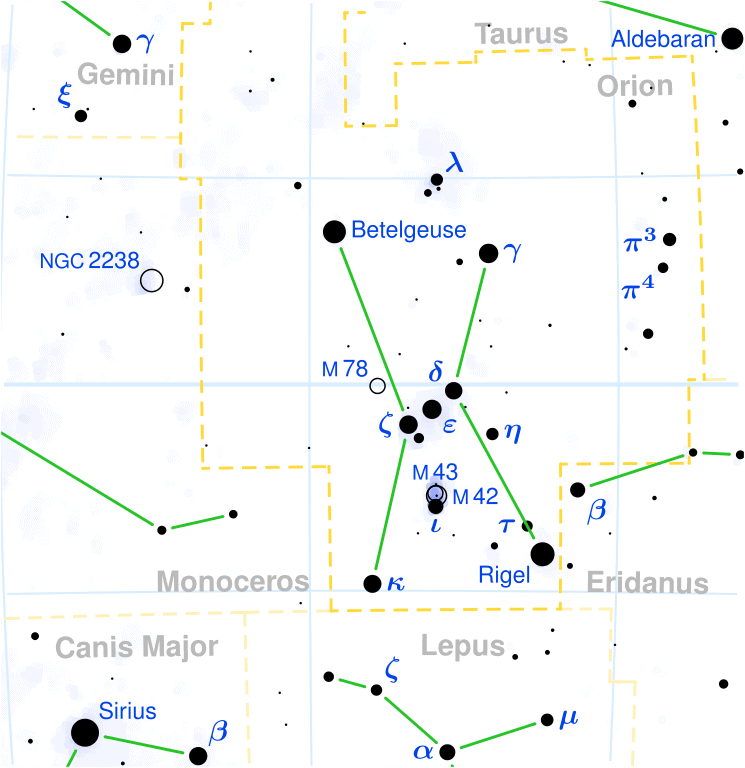
The constellation of Orion is also home to two first magnitude stars, Rigel and Betelgeuse, and it also hosts the nearest star formation region to Earth. This constellation is prominent in the sky for observers in the northern hemisphere during winter, and for observers in the southern hemisphere during summer. To southern observers, the constellation appears upside down.
The Future
Mintaka is massive enough to one day explode as a supernova. This won’t happen though for millions of years. Its unique eclipsing binary system will continue to be studied for decades since such systems and the way they work, are very much a mystery to us.
Did you know?
- When Orion is near the meridian, Mintaka is the right-most of the Belt’s stars when viewed from the Northern Hemisphere facing south.
- For the Chinese, Orion’s Belt was known as Weighing Beam. This asterism contained the stars in the belt and also a couple more from the constellation. Alnilam was known as The Third Star of Three Stars.
- Mintaka is one of the closest stars to the celestial equator. This means that the star can be used as a guidepost for finding east and west.
- The Egyptian gods Isis and Osiris were believed to have come from Orion’s Belt and Sirius to create mankind. Orion and Sirius were associated with these divine beings.
- The three pyramids on the Giza Plateau simulate the alignment of the three belt stars. The air shafts inside the pyramids point directly to the Orion constellation.
- Two large pyramids and a temple in Mexico were discovered to point directly at Orion’s belt as well. They were built in the 2nd century B.C. One of the pyramids is exactly half as tall as the Great Pyramid of Giza.
- The people of Puerto Rico and the Philippines, the three stars in Orion’s belt represented the three biblical Magi. They were named Tres Reyes Magos.
- In Finnish mythology, Orion’s belt is called Väinämöinen's Belt – a demigod, hero, and central character in the national epic Kalevala.
- In pre-Christian Scandinavia, the belt was known as Frigg’s Distaff or Freya’s Staff.
- In northwestern Mexico, the Seri people called the three belt stars Hapj – which is a name denoting a hunter.
Sources:
Image source:
- https://upload.wikimedia.org/wikipedia/commons/thumb/1/10/Orion_Belt_2009-01-29.jpg/640px-Orion_Belt_2009-01-29.jpg
- https://upload.wikimedia.org/wikipedia/commons/thumb/4/47/Orion_Head_to_Toe.jpg/498px-Orion_Head_to_Toe.jpg
- https://steemitimages.com/p/HuuaCwcKuiEnqepZjxDXXTKn4RPSWhTQ8vaSsqWuhydKaBdc6SNNzNeRrWxMHsY4YBX?format=match&mode=fit
- https://www.star-facts.com/wp-content/uploads/2019/09/Orion-stars.jpg
- https://www.star-facts.com/wp-content/uploads/2019/09/Orions-Belt-and-Orion-Nebula.jpg
- http://www.astronomytrek.com/wp-content/uploads/2017/07/Figure-1Artists-impression-of-the-triple-system-d-Ori-A-as-viewed-from-Earth-The.png
- https://upload.wikimedia.org/wikipedia/commons/thumb/b/bf/Orion_constellation_map.svg/745px-Orion_constellation_map.svg.png
